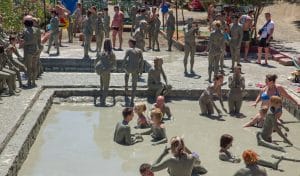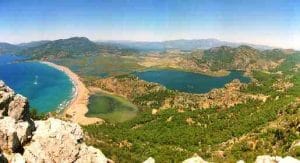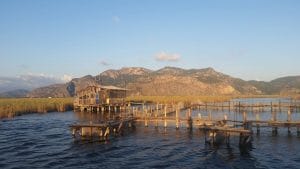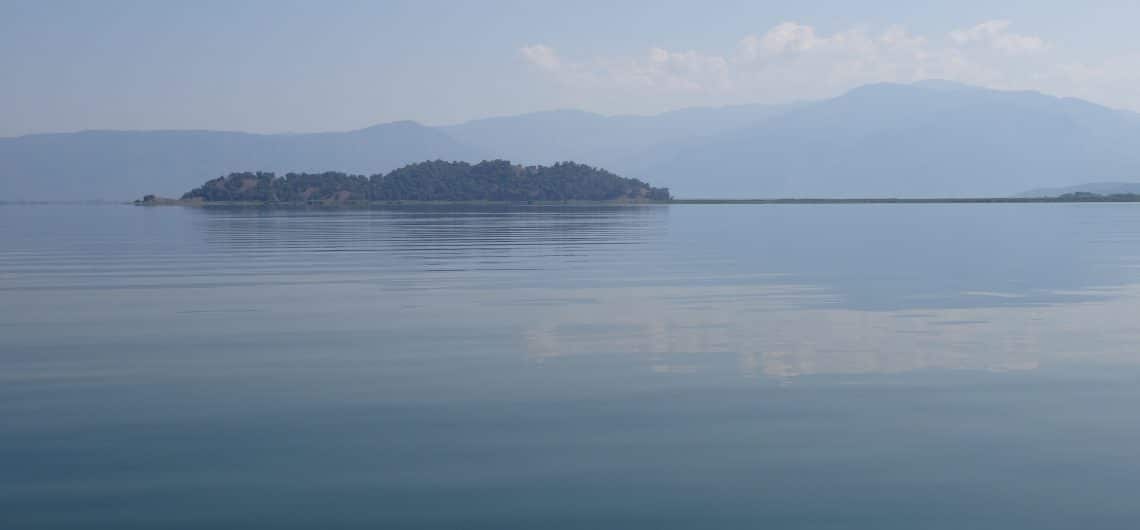Köycegiz Dalyan Special Protected Area is located in the Province of Mugla, on the southern Aegean coast of Turkey. It was one of the first three SPAs declared in July 1988, as a consequence of the Genoa Declaration of the Mediterranean Action Plan.
In 1990 the original SPA area was extended westwards. Up to now, there are fourteen natural reserves with this status, of which Pamukkale is probably the best-known. All these areas are under the supervision of the ÖÇKK, the Turkish Environmental Protection Agency for Special Areas.
The Köycegiz Dalyan SPA is one of the smaller SPAs of Turkey with a surface area 461.5 km2 although small it contains many important natural features including a fresh water lake (Köycegiz Lake), rivers (Dalyan Channel and several creeks), a delta with lagoons and wetlands, sandy beaches (Iztuzu Beach and Ekincik Beach), sloping hills covered with pine forest.
Although four towns (Köycegiz, Toparlar, Dalyan and Beyobasi) and several villages lie within the SPA, the majority is still highly valuable pristine sites. The main part of the SPA is land based, including a small marine part with a coastline of about 12 kilometers. However, the fresh and brackish water bodies including the Köycegiz Lake, Dalyan Channel and the delta comprise very important features of the SPA.
One can identify different ecosystems all over the SPA’s dry and wet lands. The sand spit of Iztuzu beach acts as a barrier between the sea and the system of estuary, lagoons and wetlands. This area is one of the top nesting sites of the loggerhead turtle (caretta caretta) in the whole Mediterranean. Protection of this endangered marine species is of international concern and has been a major activity under the Mediterranean Action Plan since the early 1980s.
 The area got its special status as a result of Prince Philip’s request to the Turkish Prime Minister Turgut Özal, protesting against the proposed construction of a hotel complex on İztuzu Beach. At the time Prince Philip was President of the WWF, and had been approached by environmentalists June Haimoff, Günther Peter, David Bellamy, Lily Venizelos, Nergis Yazgan and Keith Corbett to help stop the construction.
The area got its special status as a result of Prince Philip’s request to the Turkish Prime Minister Turgut Özal, protesting against the proposed construction of a hotel complex on İztuzu Beach. At the time Prince Philip was President of the WWF, and had been approached by environmentalists June Haimoff, Günther Peter, David Bellamy, Lily Venizelos, Nergis Yazgan and Keith Corbett to help stop the construction.
In September 1987 a construction project was suspended for an environmental impact assessment, and in 1988 the Turkish government decided upon a construction prohibition because of the area’s special significance. That was not only because of the natural importance of the beach and its significance as a turtle habitat, but also because of the cultural and historical significance and the geological importance of the Dalyan-Köyceğiz hinterland.
Dalyan has many tourist boats that travel up and down the river to the lake and the beach. This puts pressure on the ecosystem but many steps have been taken to prevent further damage. The number of boat licences is now limited and many boats have protected propellers to minimise injuries to the resident turtles.
The five kilometre long sand spit between the delta and the sea is a haven for loggerhead (caretta caretta) marine turtles. Turtles nesting along the spit have been regularly monitored (since 1986) by experts and the Dalyan Municipality. The only marine turtle rescue centre in Turkey is located at one end of the beach.
 The Sea Turtle Rescue Center (DEKAMER) was established in 2009 following an agreement between the Directorate of the Conservation of Nature and National Natural Parks and the Environmental Protection Agency for Special Areas of Turkish Ministry of Environment of Forestry, the Municipality of the Dalyan, and Pamukkale University.
The Sea Turtle Rescue Center (DEKAMER) was established in 2009 following an agreement between the Directorate of the Conservation of Nature and National Natural Parks and the Environmental Protection Agency for Special Areas of Turkish Ministry of Environment of Forestry, the Municipality of the Dalyan, and Pamukkale University.
The staff and volunteers patrol the beach and keep records during the breeding season. Injured turtles found at the beach or at the estuary are taken to the centre for treatment and rehabilitation. Turtles from further afield are also bought to the centre. The turtles have generally suffered from strikes by boat propellers but have occasionally been deliberately injured by man.
From 1 May till 1 October the beach is closed to the public between 20.00 and 08.00. This prevents the turtles and hatchlings being disturbed by activity and by artificial light. The nesting zones is marked with stakes and sunbeds and parasols are banned with the zone. Digging the sand is also prohibited.
Vehicles and pets are forbidden on the beach during nesting season and fortunately these rules are strictly enforced by security, tourists and locals alike. Speed boats are also forbidden, both on the river and within a zone of 1 mile from the coast.
The system of lake, river and lagoons supports the one of the most productive fisheries along the Aegean coast of Turkey. The fishery is managed by a cooperative formed by the residents of Dalyan and Köycegiz towns.
Tourism, fisheries and agriculture are the main economies with in the SPA. Because of its protected status, the area also offers good opportunities for ecotourism and recreation. This has become a growing market within recent years but there is still plenty of scope for expansion. Apart from agricultural land for growing citrus fruit, sesame and cotton, there are wetlands, extensive liquidambar forests, pine forests and maquis (a scrubland vegetation of the Mediterranean region, composed primarily of leathery, broad-leaved evergreen shrubs or small tree. Maquis occurs primarily on the lower slopes of mountains bordering the Mediterranean Sea. Many of the shrubs are aromatic, such as mints, laurels, and myrtles).
To the south of Lake Köyceğiz there is a fault line, along which several thermal springs are located. The only natural spa, at Sultaniye, was restored in the 90’s and again last year, and has been a popular tourist attraction ever since. The water temperature stays at a constant temperature of 40 °C. as well as the thermal springs there is also a mud bath. There is another mud bath situated further down the river on a small tributary.
The Nile turtle is often spotted around the hot springs. It is a turtle with a soft shell, hence also called African softshell turtle, which is about 1 metre in size. The species occurs near to the sea, in lagoons, lakes, rivers and canals, both in fresh and brackish waters. The Nile turtle is mainly aquatic and will only leave the water for short periods to rest in the sun. The Dalyan-Köyceğiz basin is in the utmost northwest of the species’ range.
Northeast and southeast of Köyceğiz Lake there are lowlands, the other parts of the lake are surrounded by hills. The highest of these are the Ölemez in the southwest, and Bozburun Hill in the south.
 On the river opposite Dalyan are the rock tombs of Caunos, the capital of ancient Caria. You can climb to the very top of the amphitheatre for one of the best views of Alagöl (Çandır bay) and the Dalyan delta. Apart from its cultural and historical significance, the historic city has an abundance of reptiles, birds and insects. The Special Environmental Protected Area has a total of 33 reptilian species and the majority if these can be found at Caunos.
On the river opposite Dalyan are the rock tombs of Caunos, the capital of ancient Caria. You can climb to the very top of the amphitheatre for one of the best views of Alagöl (Çandır bay) and the Dalyan delta. Apart from its cultural and historical significance, the historic city has an abundance of reptiles, birds and insects. The Special Environmental Protected Area has a total of 33 reptilian species and the majority if these can be found at Caunos.
The Dalyan estuary is a labyrinth of canals through the reeds. At the west side of the delta is Alagöl, the bay of Çandır, which is heated by a number of thermal springs. The further you dive down into the water the hotter it gets. The mud at the bottom of the lake is also reputed to make you look 20 years younger.
 The opposite end of the beach is reached by road. It winds through the wetlands and hugs the bottom of the large mountains. In spring you can witness eagles and peregrine falcons wheeling above your head. The route then follows the shore of Sülüngür Lake. This is closed to boat traffic by a dalyan or fishing weir.
The opposite end of the beach is reached by road. It winds through the wetlands and hugs the bottom of the large mountains. In spring you can witness eagles and peregrine falcons wheeling above your head. The route then follows the shore of Sülüngür Lake. This is closed to boat traffic by a dalyan or fishing weir.
On Bozburun Tepesi above İztuzu Beach lies a radar station. A must visit for the spectacular vista of the Köyceğiz-Dalyan SEPA and the perfect spot to watch the sun set over the bay. On our Blue Thermal Lagoon trips, we stop by at this spectacular sight to take pictures of the most beautiful view of Dalyan Delta, Iztuzu Beach, koycegiz Lake and Dalyan.


Comments